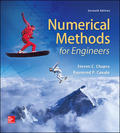
Use zero- through fourth-order Taylor series expansions to predict
To calculate: The approximate value of
Answer to Problem 6P
Solution:
The zero first, second, third and fourth order Taylor series approximations for the function
The result shows that theTaylor series approximation could be generalised as,
Explanation of Solution
Given Information:
The function
Formula Used:
The Taylor series approximation of
Calculation:
Consider the zero-order approximation for the provided function,
Now replace 2.5 for
The zero order approximation gives 0.
The exact value of the function at 2.5 would be:
Thus, the true relative percentage error would be:
The relative percentage error at this stage is 100%.
The first-order Taylor series approximation would be:
Now replace 2.5 for
The first order approximation gives 1.5.
Thus,
The relative percentage error at this stage is 38.91%.
The second-order Taylor series approximation would be:
Now replace 2.5 for
The second order approximation gives 0.375.
Thus,
The relative percentage error at this stage is 59.07%.
The third-order Taylor series approximation would be:
Now replace 2.5 for
The third order approximation gives 1.5.
Thus,
The relative percentage error at this stage is 63.7%
The fourth-order Taylor series approximation would be:
Now replace 2.5 for
The third order approximation gives 0.2344.
Thus,
The relative percentage error at this stage is 74.42%.
This implies that the Taylor series approximation could be generalised as,
Want to see more full solutions like this?
Chapter 4 Solutions
EBK NUMERICAL METHODS FOR ENGINEERS
Additional Engineering Textbook Solutions
Math in Our World
A Problem Solving Approach To Mathematics For Elementary School Teachers (13th Edition)
Probability And Statistical Inference (10th Edition)
Elementary Statistics: Picturing the World (7th Edition)
Precalculus
Finite Mathematics for Business, Economics, Life Sciences and Social Sciences
- Let A = {a, b, c, d}, B = {a,b,c}, and C = {s, t, u,v}. Draw an arrow diagram of a function for each of the following descriptions. If no such function exists, briefly explain why. (a) A function f : AC whose range is the set C. (b) A function g: BC whose range is the set C. (c) A function g: BC that is injective. (d) A function j : A → C that is not bijective.arrow_forwardLet f:R->R be defined by f(x)=x^(3)+5.(a) Determine if f is injective. why?(b) Determine if f is surjective. why?(c) Based upon (a) and (b), is f bijective? why?arrow_forwardLet f:R->R be defined by f(x)=x^(3)+5.(a) Determine if f is injective.(b) Determine if f is surjective. (c) Based upon (a) and (b), is f bijective?arrow_forward
- 1 S 0 sin(lnx) x² - 1 Inx dxarrow_forward2 6. Modelling. Suppose that we have two tanks (A and B) between which a mixture of brine flows. Tank A contains 200 liters of water in which 50 kilograms of salt has been dissolved and Tank B contains 100 liters of pure water. Water containing 1kg of salt per liter is pumped into Tank A at the rate of 5 liters per minute. Brine mixture is pumped into Tank A from Tank B at the rate of 3 liters per minute and brine mixture is pumped from Tank A into Tank B at the rate of 8 liters per minute. Brine is drained from Tank B at a rate of 5 liters per minute. (a) Draw and carefully label a picture of the situation, including both tanks and the flow of brine between them. JankA 1ks of Salt Slits Pump EL Brine mit tark A from tank 13 Tank 13 k 3L zooliters of Ico liters of water with pure water. Saky salt → 777 disslore inside Brine mix is pumped from tank A to B of 82 Brine drainen min by Gf salt (b) Assume all brine mixtures are well-stirred. If we let t be the time in minutes, let x(t) 1ks…arrow_forwardNo chatgpt plsarrow_forward
- Remix 4. Direction Fields/Phase Portraits. Use the given direction fields to plot solution curves to each of the given initial value problems. (a) x = x+2y 1111 y = -3x+y with x(0) = 1, y(0) = -1 (b) Consider the initial value problem corresponding to the given phase portrait. x = y y' = 3x + 2y Draw two "straight line solutions" passing through (0,0) (c) Make guesses for the equations of the straight line solutions: y = ax.arrow_forwardIt was homeworkarrow_forwardNo chatgpt pls will upvotearrow_forward
- Algebra & Trigonometry with Analytic GeometryAlgebraISBN:9781133382119Author:SwokowskiPublisher:Cengage
 Trigonometry (MindTap Course List)TrigonometryISBN:9781337278461Author:Ron LarsonPublisher:Cengage Learning
Trigonometry (MindTap Course List)TrigonometryISBN:9781337278461Author:Ron LarsonPublisher:Cengage Learning


